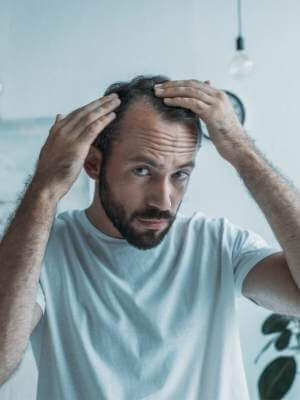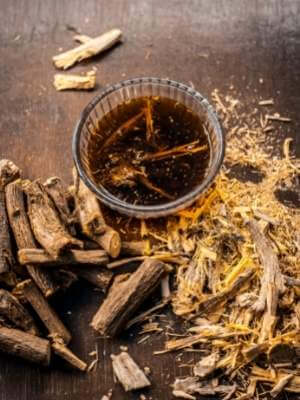While minoxidil is widely used in the hair loss community, not everyone wants to include it in their hair growth routine. Ayurvedic Substitute for Minoxidil and DHT Blockers can help with this. Many natural solutions can not only be more effective than minoxidil, but they can also have fewer adverse effects.
Table of Contents
What is Minoxidil?

Male pattern baldness, the most prevalent kind of hair loss in males, is caused by the actions of an androgen hormone called dihydrotestosterone, or DHT, as you may have read if you searched online for information on managing hair loss.
DHT can miniaturize your hair follicles and stop them from developing new hairs over time if you’re genetically inclined to hair loss. The hairline and vertex scalp, often known as the crown, are frequently affected by this condition.
In the treatment of male pattern baldness, minoxidil (Rogaine) solution and foam are used to promote hair growth. Women with thinning hair can also use the foam and 2% minoxidil solution to promote hair growth. Minoxidil is a type of medicine known as a vasodilator, and it doesn’t appear to have any effect on DHT levels, thus it won’t “protect” your hair from DHT’s effects.
For many men, however, it can increase hair growth and make thinning hair patches on the scalp look thicker, fuller, and less affected by hair loss.
Ayurvedic Substitute for Minoxidil
It’s difficult not to be stressed out if you’re experiencing hair loss and don’t know why it’s happening, which leads to additional hair loss. This becomes a vicious loop that continues until you are driven to a doctor’s office, where your wallet is drained in minutes. Medicines, vitamins, and serums of all kinds rob you of your money with no promise of healing. Ayurveda comes to your aid in such a situation.
Ayurveda has a variety of natural hair regrowth remedies that are both simple and safe, as well as affordable.
So, here is a list of the four greatest Ayurvedic cures for hair loss that you can consider.
-
Bhringaraj
-
Amla
-
Flax Seeds
-
Yashtimadhu
Bhringaraj

For ages, Ayurvedic practitioners have utilized Bhringraj, also known as Eclipta alba, to treat a variety of health problems. It’s also been used in other traditional treatments for a long time. Bhringraj has been used for its various benefits for hair development, in addition to its therapeutic purposes. Several research has looked into the effects of Bhringraj on hair health and growth capacity. It’s also being researched as a possible therapy for alopecia. Alopecia, sometimes known as baldness, is a prevalent hair disorder that affects people of all ages and races. Alopecia affects approximately 50% of men, and it is thought that an equal amount of women suffer from the condition. Alopecia can be induced by a high level of a certain androgen hormone. Hair loss can occur as a result of cancer therapies, immunosuppressive medicines, and skin and scalp problems like dermatitis. A study was carried out on nude mice that were genetically devoid of hair due to defective keratinization. Keratinization is the process of keratin replacing the cytoplasm in the outermost cells of the mammalian epidermis. It permits millions of dead cells to be shed from the body, and its waterproof protein gives skin and hair strength and resiliency. (Source)
Bhringraj (Eclipta alba) was evaluated against Minoxidil as a control in another study. The results of the investigation revealed that the rats given Bhringraj were not only similar to Minoxidil but actually outperformed the top medicine! It was cited by researchers as a tried-and-true natural treatment for hair loss. (Source)
The effects of Eclipta alba on hair development are thought to be due to its ability to prolong the anagen phase of hair, keeping follicles in place for longer. After seven weeks of treatment, 75 percent of subjects with mild to moderate hair loss reported a significant reduction in hair loss in one study!
Bhringraj has been used in Ayurvedic medicine for ages to encourage hair growth and treat other common ailments. Multiple studies have shown that using it boosts hair development and may even extend the life of existing hair strands by extending the anagen phase of the hair cycle. Bhringraj is a helpful natural remedy for persons suffering from hair loss, especially when paired with other growth-promoting herbs.
Amla (Indian Gooseberry)

One of the most nutritious herbs for the hair is Amla, also known as Amrit (nectar). It has a wide range of therapeutic properties and can be consumed in raw, oil, or powdered form. It functions as a natural conditioner and thickens and strengthens the hair. Amla is high in linoleic acid, oleic acid, and polyphenols, all of which help to prevent DHT. It is also high in iron and protein, which aids in the development of softer, shinier, and more voluminous hair. (Source)
Amla’s phytonutrients, vitamins, and minerals aid to improve scalp circulation and promote healthy hair development. Collagen protein is produced by amla’s vitamin C. This aids in hair growth, both in terms of length and volume. Collagens help to regenerate hair follicles by replacing dead cells with new ones. Drinking amla juice on a regular basis or applying it topically might make your hair thicker and more bouncy due to its nutrients and other helpful features.

Flax Seeds
Flax seeds are high in -linolenic acid, an omega-3 fatty acid, and the antioxidant lignan secoisolariciresinol diglucoside, a lignan that inhibits DHT and improves skin and hair problems. You can eat flax seeds on a daily basis or sprinkle a few drops of flaxseed oil into your hair oil and gently massage it into your scalp.
Two animal trials were conducted, both of which demonstrated the benefits of flaxseed supplementation.
The first study, conducted in 2013, looked at the impact of several plant-based lignans on DHT levels. Flaxseed was taken orally as powdered flaxseed or as a petroleum extract.
The study focused on prostate weight in castrated male rats, as lower weight indicates less androgenic activity.
Flax extracts, both powdered and ethanol extracts, were found to reduce prostate weight and testosterone levels. Both of these are strong markers of inhibition of 5-alpha-reductase.
Yashtimadhu (Licorice)

Licorice root is an anti-androgen and a natural DHT (dihydrotestosterone) blocker. Androgens can cause an overabundance of DHT, which, if not properly metabolized by the body, can adhere to the hair follicle and cause patterned baldness. DHT causes the hair follicle to shrink, cutting off its blood supply, depriving the hair shaft of nourishment. Licorice root possesses phytoestrogen properties, lowering testosterone levels that might lead to excessive DHT. In addition to promoting hair development, licorice is a powerful scalp calming herb that effectively heals scalp irritation, scabs, and dandruff. (Source)
Conclusion
With the rise in DHT-blocking medications, shampoos, and supplements, it’s clear that preventing male pattern baldness requires DHT blocking. You can use those options depending on your stage of male pattern baldness. Ayurvedic DHT blockers can be utilized as preventative and reversible DHT reduction strategies. Unfortunately, there isn’t a comprehensive, conclusive way for dealing with DHT. It differs from one person to the next, based on product compatibility and hormonal structure. Most pharmacological medicines, more often than not, have various degrees of usefulness as well as a set of adverse effects.
Many men opt for natural techniques of DHT blocking to avoid the dangerous side effects while revitalizing their hair, and Ayurveda offers a full treasure of powerful treatments that will reshape your confidence as well as your hairline.

Creative, versatile, and passionate about her craft, Rupa Das is a well-recognized name in the world of fashion and makeup! This is a woman who has been in the fashion and makeup industry for 24 years and is still one of the leading international makeup artist in the circuit! She has worked in big brands like Lakme, Green Trends, Colors and transitioned to become a Beauty (Hair & Skin) Trainer.